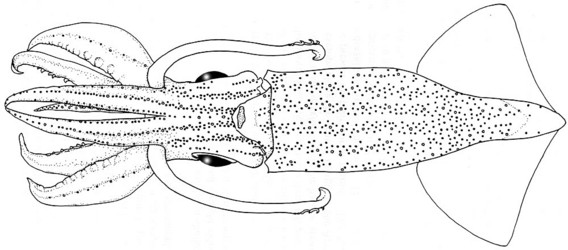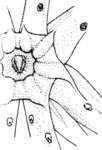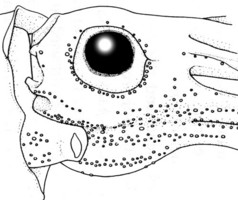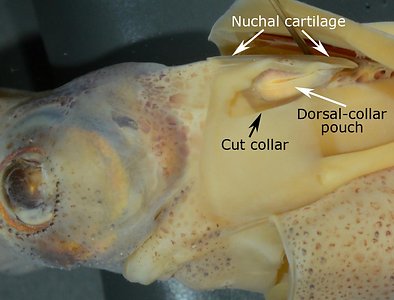Abralia fasciolata
Kotaro TsuchiyaIntroduction
A. fasciolata is of moderate size, males reaching, at least 27 mm ML and females 38 mm ML. It is very distinctive and easily recognized by its striped photophore arrangement on mantle. This species is similar to A. marisarabica in the mantle photophore arrangement, buccal lappet connectives and eye photophores, but is easily distinguishable by its larger mature size, and the larger number of integumental photophores on the mantle.
Characteristics
.- Arms
- Buccal connectives: Buccal-support connectives attached to the dorsal side of Arm III (DDDD-type).
- Buccal connectives: Buccal-support connectives attached to the dorsal side of Arm III (DDDD-type).
- Tentacle clubs
- Two or three hooks on ventral side.
- Two rows of large suckers on dorsal side of manus.
- Hectocotylus
- Right ventral arm of male hectocotylized.
- Hectocotylus with two very differently-sized flaps: large, bilobed proximal flap on ventral margin and small distal flap on dorsal margin.
- Eye Photophores
- Five silvery organs with three to five minute additional organs in between.
- Integumental Photophores
- Ventral mantle with six broad longitudinally arranged stripes of integumental organs which become diffuse posteriorly.
- Ventral head with seven longitudinally arranged stripes of integumental organs; unpaired middle row is with few photophores.
- Reproductive structures
- Spermatangia receptacles: Spermatrangia lie within a pocket inside the Dorsal-collar pocket called the Dorsal-collar pouch. See similar arrangement in A. similis.
- Spermatangia receptacles: Spermatrangia lie within a pocket inside the Dorsal-collar pocket called the Dorsal-collar pouch. See similar arrangement in A. similis.
Comment
This species is similar to A. marisarabica and A. dubia in its strange arrangement of buccal connectives and unusual eye photophores.
Nesis (1993) suggested this species is a synonym of the poorly known species, Abralia dubia (Adam, 1960).
Distribution
Geographical Distribution
This species is known only from the type locality, the Gulf of Aqaba, Red Sea.References
Nesis, K. N. 1993. Cephalopods from the Saya de Malha Bank, Indian Ocean. Trans. P.P. Shirshov Institute of Oceanology of the USSR Academy of Sciences, 128: 26-39. [In Russian with English summary]
Tsuchiya, K. 1991. Abralia fasciolata, a new species of enoploteuthid squid from the western Indian Ocean (Cephalopoda: Oegopsida). Bulletin of the National Science Museum, (series A) 17(2):69-79, 16 figures.
Title Illustrations

About This Page

Tokyo University of Fisheries, Tokyo, Japan
Page copyright © 2018
All Rights Reserved.
- Content changed 21 January 2014
Citing this page:
Tsuchiya, Kotaro. 2014. Abralia fasciolata . Version 21 January 2014 (under construction). http://tolweb.org/Abralia_fasciolata/19664/2014.01.21 in The Tree of Life Web Project, http://tolweb.org/















 Go to quick links
Go to quick search
Go to navigation for this section of the ToL site
Go to detailed links for the ToL site
Go to quick links
Go to quick search
Go to navigation for this section of the ToL site
Go to detailed links for the ToL site